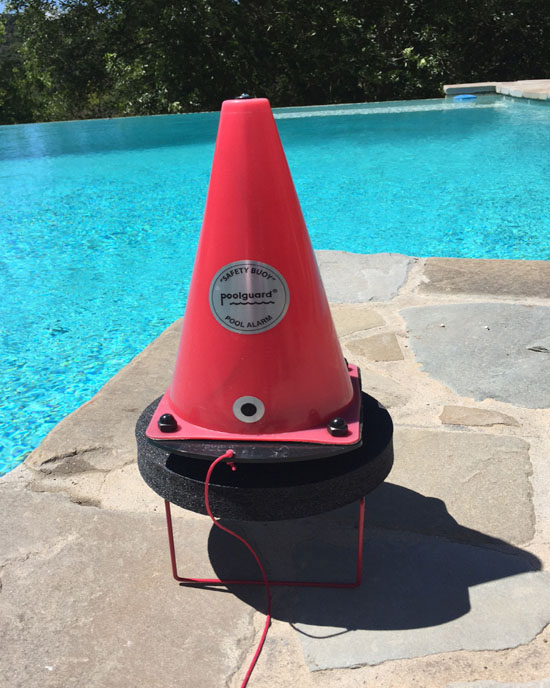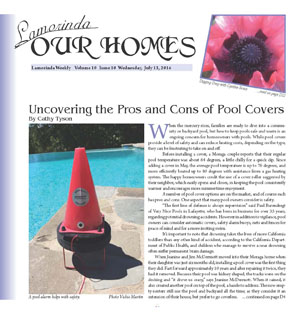| | Published July 13th, 2016
| Uncovering the Pros and Cons of Pool Covers
| | | By Cathy Tyson |  | | A pool alarm helps with safety. Photo Vickie Martin |
When the mercury rises, families are ready to dive into a community or backyard pool, but how to keep pools safe and warm is an ongoing concern for homeowners with pools. While pool covers provide a level of safety and can reduce heating costs, depending on the type, they can be frustrating to take on and off.
 Before installing a cover, a Moraga couple reports that their regular pool temperature was about 64 degrees, a little chilly for a quick dip. Since adding a cover in May, the average pool temperature is up to 76 degrees, and more efficiently heated up to 80 degrees with assistance from a gas heating system. The happy homeowners credit the use of a cover roller suggested by their neighbor, which easily opens and closes, in keeping the pool consistently warmer and encourages more summertime enjoyment.
Before installing a cover, a Moraga couple reports that their regular pool temperature was about 64 degrees, a little chilly for a quick dip. Since adding a cover in May, the average pool temperature is up to 76 degrees, and more efficiently heated up to 80 degrees with assistance from a gas heating system. The happy homeowners credit the use of a cover roller suggested by their neighbor, which easily opens and closes, in keeping the pool consistently warmer and encourages more summertime enjoyment.
 A number of pool cover options are on the market, and of course each has pros and cons. One aspect that many pool owners consider is safety.
A number of pool cover options are on the market, and of course each has pros and cons. One aspect that many pool owners consider is safety.
 "The first line of defense is always supervision" said Paul Barendregt of Very Nice Pools in Lafayette, who has been in business for over 35 years, regarding potential drowning accidents. However in addition to vigilance, pool owners can consider automatic covers, safety alarm buoys, nets and fences for peace of mind and for a more inviting swim.
"The first line of defense is always supervision" said Paul Barendregt of Very Nice Pools in Lafayette, who has been in business for over 35 years, regarding potential drowning accidents. However in addition to vigilance, pool owners can consider automatic covers, safety alarm buoys, nets and fences for peace of mind and for a more inviting swim.
 It's important to note that drowning takes the lives of more California toddlers than any other kind of accident, according to the California Department of Public Health, and children who manage to survive a near drowning often suffer permanent brain damage.
It's important to note that drowning takes the lives of more California toddlers than any other kind of accident, according to the California Department of Public Health, and children who manage to survive a near drowning often suffer permanent brain damage.
 When Jeanine and Jim McDermott moved into their Moraga home when their daughter was just six months old, installing a pool cover was the first thing they did. Fast forward approximately 10 years and after repairing it twice, they had it removed. Because their pool was kidney shaped, the tracks were on the decking and "it drove us crazy," says Jeanine McDermott. When it rained, it also created another pool on top of the pool, a hassle to address. The now empty-nesters still use the pool and backyard all the time, as they consider it an extension of their house, but prefer to go coverless. They have a pool service that comes regularly to adjust the chemicals and keep the pool clean.
When Jeanine and Jim McDermott moved into their Moraga home when their daughter was just six months old, installing a pool cover was the first thing they did. Fast forward approximately 10 years and after repairing it twice, they had it removed. Because their pool was kidney shaped, the tracks were on the decking and "it drove us crazy," says Jeanine McDermott. When it rained, it also created another pool on top of the pool, a hassle to address. The now empty-nesters still use the pool and backyard all the time, as they consider it an extension of their house, but prefer to go coverless. They have a pool service that comes regularly to adjust the chemicals and keep the pool clean.
 In Lafayette, Vickie and Jeff Martin have a lovely pool, no small children living at home, but two pugs who are not good swimmers, due to their short legs and barrel-shaped bodies. After a recent pool remodel, they opted not to get a pool cover and instead purchased a safety buoy that is designed to float in the pool and detect when something 18 pounds or more falls into the pool. It comes with a house remote receiver that works up to 200 feet away. On a recent day however, the buoy was loudly beeping for no apparent reason. Sonny the pug was also sounding an alarm by barking at the beeping buoy.
In Lafayette, Vickie and Jeff Martin have a lovely pool, no small children living at home, but two pugs who are not good swimmers, due to their short legs and barrel-shaped bodies. After a recent pool remodel, they opted not to get a pool cover and instead purchased a safety buoy that is designed to float in the pool and detect when something 18 pounds or more falls into the pool. It comes with a house remote receiver that works up to 200 feet away. On a recent day however, the buoy was loudly beeping for no apparent reason. Sonny the pug was also sounding an alarm by barking at the beeping buoy.
 There are similar alarms that attach to the edge of the pool that have an underwater sensor which will trigger an alarm on a remote receiver in the house when an object 18 pounds or more falls into the water. This may not be the best option for families with cats or very small dogs, and doesn't address evaporation or heat loss.
There are similar alarms that attach to the edge of the pool that have an underwater sensor which will trigger an alarm on a remote receiver in the house when an object 18 pounds or more falls into the water. This may not be the best option for families with cats or very small dogs, and doesn't address evaporation or heat loss.
 On the upper end of the price spectrum are convenient motorized pool covers that are very safe, keep the heat in and the leaves and debris out. But these can run in the $9,000 to $10,000 range. With a new pool installation, these can easily be included in the design, so the tracks are underneath the lip of the pool. It's also possible to retrofit an existing rectangular pool, with the tracks are on top of the pool decking.
On the upper end of the price spectrum are convenient motorized pool covers that are very safe, keep the heat in and the leaves and debris out. But these can run in the $9,000 to $10,000 range. With a new pool installation, these can easily be included in the design, so the tracks are underneath the lip of the pool. It's also possible to retrofit an existing rectangular pool, with the tracks are on top of the pool decking.
 All summer long, scores of swim team kids as well as adults are using the recently remodeled pool at the Moraga Country Club. Aquatic Director Sean Mason, reports they have tried an enzyme barrier cover, but due to the lane ropes and windy conditions, it had "limited" success. This type of cover works best on indoor pools, said Mason. Unfortunately there was no room for big bulky cover storage reels in the new design, so the pool goes uncovered, but there is a large, secure fence around the exterior of the pool area.
All summer long, scores of swim team kids as well as adults are using the recently remodeled pool at the Moraga Country Club. Aquatic Director Sean Mason, reports they have tried an enzyme barrier cover, but due to the lane ropes and windy conditions, it had "limited" success. This type of cover works best on indoor pools, said Mason. Unfortunately there was no room for big bulky cover storage reels in the new design, so the pool goes uncovered, but there is a large, secure fence around the exterior of the pool area.
 Manual covers can cost under $100 and block dirt and leaves from a pool, transmit the heat from the sun to the water, and prevent evaporation. However it can be aggravating getting it on and off. Some homeowners use this type of cover in the winter months, when it's likely the pool won't be used much.
Manual covers can cost under $100 and block dirt and leaves from a pool, transmit the heat from the sun to the water, and prevent evaporation. However it can be aggravating getting it on and off. Some homeowners use this type of cover in the winter months, when it's likely the pool won't be used much.
 Mesh covers are attached to the pool deck using anchors with stainless steel springs, which provide protection from the elements, debris, as well as accidental drowning or entrapment of loved ones and pets. Similarly, but less solid, net covers attach with anchors around the perimeter of the pool - there are no heat or evaporations savings with these, but they do offer a barrier that is tight enough that if someone accidentally takes a tumble into the pool, they won't drown.
Mesh covers are attached to the pool deck using anchors with stainless steel springs, which provide protection from the elements, debris, as well as accidental drowning or entrapment of loved ones and pets. Similarly, but less solid, net covers attach with anchors around the perimeter of the pool - there are no heat or evaporations savings with these, but they do offer a barrier that is tight enough that if someone accidentally takes a tumble into the pool, they won't drown.
 A jackhammer is another alternative. In the 1960s and 1970s as Lamorinda suburbs were sprouting, with no thought of drought, developers were busy installing pools into smallish backyards. As those houses eventually turned over, a number of homeowners opted to simply fill in the pool and landscape over the top, adding to their usable backyard space. For those with vintage pools and pool equipment, this is a much more economical choice than taking on an expensive remodel that will likely include new plaster, tile and coping, not to mention a new heater and plumbing.
A jackhammer is another alternative. In the 1960s and 1970s as Lamorinda suburbs were sprouting, with no thought of drought, developers were busy installing pools into smallish backyards. As those houses eventually turned over, a number of homeowners opted to simply fill in the pool and landscape over the top, adding to their usable backyard space. For those with vintage pools and pool equipment, this is a much more economical choice than taking on an expensive remodel that will likely include new plaster, tile and coping, not to mention a new heater and plumbing.
 California's Health and Safety Code requires private pools built or remodeled after 1998 feature at least one of seven safety devices. The list includes a fence, approved pool cover, an alarm on each house door that accesses the pool or a pool-use alarm that alerts the homeowner when someone enters the water.
California's Health and Safety Code requires private pools built or remodeled after 1998 feature at least one of seven safety devices. The list includes a fence, approved pool cover, an alarm on each house door that accesses the pool or a pool-use alarm that alerts the homeowner when someone enters the water.

|
| | | | | | | | | | | | |





